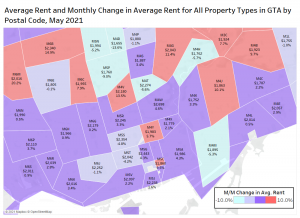The rental listing showed a great home in an excellent location near Dundas and Ossington. It described a clean, happy house for female renters at a really reasonable price.
But this story isn’t about a happy house full of happy renters. Instead, it’s a warning about a real-life rental scam that happened here in Toronto.

The story
The story was described by Kat Shermack on Toronto Life. Shermack met a girl from Vancouver named Karla who had moved into a large home that she thought she’d share with three other girls. In reality, within a very short period, about 25 young women lived in the house, on mattresses crammed together in nearly every corner of every room. Most were new to Canada, foreign students and visitors. Only a few were native English speakers.
The original story is shocking, and the way it all went down is scary: When Karla moved in there were just a few girls living there. She signed a “room agreement” that outlined a cleaning schedule and some weird rules, such as that all shoes had to be kept at the back of the house. And her landlord’s name was nowhere on the agreement. Nevertheless, attracted by the great location and the awesome price of $700/month, she signed.
For renters in Toronto, the story of this rental scam might not sound familiar, and it shouldn’t – most rental scams we hear about involve listings that look too good to be true, with landlords that are out of the country and require payment via wire transfer, with the promise of the keys being sent in the mail upon receipt of rent.
This story is vastly different. The house actually exists and the tenants got to meet their landlord and see the place before moving in. There was a signed agreement. The tenants got to move in. It doesn’t have the classic signs of a terrible scam.

Beautiful, but dangerous.
Avoid rental scams
On the surface, it seems the tenants of this rental scam did everything right – they saw the place in person, met the landlord and signed an agreement. But it’s the details that led to the scam, and that’s where the lesson lies for avoiding something like this ever happening to you.
- Paperwork you’ll need for rent application
- Don’t have renter’s insurance for your Toronto apartment? Here’s what you’re risking (It’s pretty serious!)
The important element here is the “room agreement” that the tenant signed – it’s not the same thing as a lease, tenancy agreement or rental agreement.
The CMHC has some good information that tenants need to know about what should be included in your lease. Here is, at minimum, what should be included in any agreement you sign with your landlord:
- the names of the landlord and tenant(s);
- the address of the rental property;
- the agreed upon monthly rent, with or without utilities, parking, cable;
- when the rent is due, for example, on the first day of each month;
- the amount and terms of the deposit, if applicable;
- which repairs are your responsibility and your obligation to do repairs at the request of the landlord;
- the term of rental period, typically one-year, (month-to-month, or week-to-week);
- the notice period that the tenant is required to give when terminating a tenancy, such as, 60 days notice to terminate;
- the amount of the (security or damage deposits), if applicable;
- subletting rules;
- allowable rent increases;
- specific restrictions, such as no boarders, pets, smoking, waterbeds;
- when and how a landlord can enter the residential premises;
- conditions for termination of a lease;
- terms for dispute resolution: late payment, damage and repairs, eviction;
- emergency contact information for tenant and landlord (include phone, fax and email)
With a document signed by you, the renter, and the landlord, both parties have an agreement in pace that will hold up if problems arise. In the case of serious problems, the landlord or tenant can contact the Landlord and Tenant Board of Ontario, or for more information about your rights, you can check out the Residential Tenancies Act.

Read the fine print!
The conclusion
In the end, it turned out that the landlord, Jesse Gubb, wasn’t the actual owner of the house. He had rented it from the owner who was living abroad, and subletted the house dozens of women. He likely left his name off the “room agreement” intentionally, to save his skin should anyone ever take him to court. It was later discovered that he illegally subletted four other houses out to a ton of renters.
Gubb was charged with 44 fire code violations and was on the hook for up to $2.2 million in fines for his scam.
More on recognizing scams:
Use a tool like TorontoRentals to screen for potential apartments safely.




